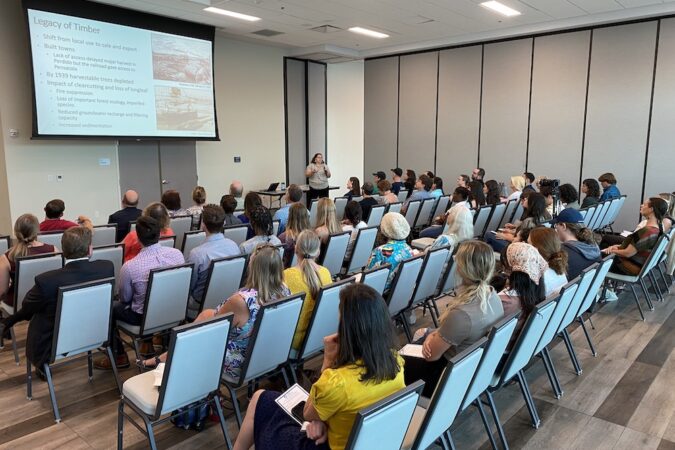
Estuary Program Awards New Round of Grants
By Jeremy Morrison
Local environmental efforts focused on the local watershed have received a fresh infusion of funding, with the Pensacola and Perdido Bay Estuary Program awarding about a quarter of a million dollars in community grants for the coming year. This new round of environmental funding was announced on Sept. 22 during the estuary program’s second annual community grant symposium.
The largest beneficiary of this new round of funding is the Blackwater Soil and Water Conservation District, which landed $50,000 for a no-till seed drill rental program. The program is designed to encourage and assist farmers with implementing no-till crop production, which should improve soil health, reduce erosion and improve water quality. Funding will be used to establish an equipment rental program that farmers can tap for a minimal fee as they work to implement no-till practices.
Securing nearly as much funding — at $49,998.99 — is EscaRosa OysterCorps. Looking to expand and continue its Franklin’s Promise/Conservation Corps of the Forgotten and Emerald Coasts program, this organization will use the funding to continue efforts to protect local shorelines by collecting and recycling oyster shells, growing native marsh plants and implementing restoration projects.
Next in line is the University of West Florida, which was awarded $39,326.75 for its Zooplankton Ecology and Water Quality Monitoring of Perdido Bay project. This project will focus on monitoring ambient water quality in Perdido Bay and its tributaries to study a decline in organisms that have a larval zooplankton stage and possible solutions to restoration efforts.
UWF also got $31,550 for a separate project examining stream bank erosion in the Pensacola Bay and Perdido Bay watersheds. This project is of the data-gathering variety, with the funding being used to collect stream bank profiles at 30 sites within the watershed to calculate annual erosion rates, with the information to be used when determining potential management and restoration efforts.
Northwest Florida State College was awarded $23,630.48 for its project centered on peripheral oyster mapping in Santa Rosa Sound and urban bayous of Pensacola Bay; peripheral oysters are important for water filtration and provide habitat for numerous aquatic species. Creating maps of the region’s peripheral oyster distribution will give a clearer picture of population dynamics and also help guide future restoration efforts.
The PPBEP awarded $22,678.15 to the National Wildlife Federation for a project that signals some new territory for the region: protecting manatees. In recent years an increasing number of manatees have been reported in local waterways. This project aims to increase public awareness of this fact by educating waterway users and coastal residents. With this grant, NWF will work to inform the public and, in doing so, improve the prospects for both the manatees and their habitat.
To educate and immerse local students, the Santa Rosa County School District’s Navarre Beach Marine Science Station was awarded $19,615.63 for its project entitled Empowering Students to Take Action: Aquatic Care Team. As part of this project, 50 high school students will use scientific methods and technologies to explore the environmental variables and water quality in Santa Rosa Sound. The data collected during this project will be input into the Gulf Coast Ocean Observation Systems (GCOOS) database.
Finally, Escambia County was awarded $13,200 for a landscaping workshop and plant giveaway. This grant will build upon a project from last year — the Perdido Key Coastal Demonstration Garden, installed in April — and is designed to educate the public about native species of plants. In addition to the landscape workshop and native plant giveaway, this project — planned in partnership with the UF/IFAS Escambia Extension office — will also update the landscaping guide created this year to include a list of local nurseries which carry native species.



